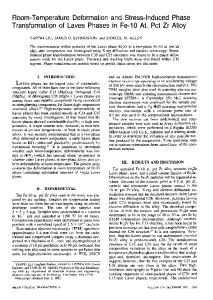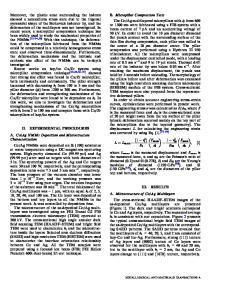Room temperature deformation mechanisms of Mg/Nb nanolayered composites
- PDF / 3,477,575 Bytes
- 23 Pages / 584.957 x 782.986 pts Page_size
- 105 Downloads / 320 Views
Manish Jain and Siddhartha Pathak Chemical and Materials Engineering, University of Nevada, Reno, Nevada 89557, USA
Anil Kumar Theoretical Division, Los Alamos National Laboratory, Los Alamos, New Mexico 87545, USA
Nan Li, Nathan A. Mara, and J. Kevin Baldwin Center for Integrated Nanotechnologies, Los Alamos National Laboratory, Los Alamos, New Mexico 87545, USA
Irene J. Beyerleina) Mechanical Engineering Department, Materials Department, University of California at Santa Barbara, Santa Barbara, California 93106, USA (Received 8 February 2018; accepted 6 April 2018)
In this work, the deformation mechanisms underlying the room temperature deformation of the pseudomorphic body centered cubic (BCC) Mg phase in Mg/Nb nanolayered composites are studied. Nanolayered composites comprised of 50% volume fraction of Mg and Nb were synthesized using physical vapor deposition with the individual layer thicknesses h of 5, 6.7, and 50 nm. At the lower layer thicknesses of h 5 5 and 6.7 nm, Mg has undergone a phase transition from HCP to BCC such that it formed a coherent interface with the adjoining Nb phase. Micropillar compression testing normal and parallel to the interface plane shows that the BCC Mg nanolayered composite is much stronger and can sustain higher strains to failure than the HCP Mg nanolayered composite. A crystal plasticity model incorporating confined layer slip is presented and applied to link the observed anisotropy and hardening in the deformation response to the underlying slip mechanisms.
I. INTRODUCTION
Two-phase nanolayered metallic thin films fabricated by deposition techniques, such as magnetron sputtering, present an unusual structure whose crystals are nanoscale in dimension and the biphase interfaces, thus, closely spaced and high in volume fraction of coarser layered composites. In this way, nanolayered composite thin films can permit the study of interface-driven phenomena, not possible in coarse-grained composites.1–7 One outstanding example is the formation of pseudomorphic phases, during the fabrication of nanolayered thin films. Epitaxial growth can be exploited to cause the deposited layer to match the lattice of the underlying substrate. Provided that the layer thickness is sufficiently fine, the drive to create a low energy, coherent bimetal interface can induce a phase transformation of the deposited metal layer from its stable form under ambient conditions.8 Of the two dissimilar metals that are joined at their common interface, one metal adopts the crystal a)
Address all correspondence to this author. e-mail: [email protected] This paper has been selected as an Invited Feature Paper. DOI: 10.1557/jmr.2018.107
structure of the other.8 The new phase is a pseudomorphic phase. Above a critical layer thickness, the metal reverts back to its original phase under ambient conditions since misfit dislocations get introduced into the interface, which allow for coherency strain relaxation. Thus, to retain the transformed pseudomorphic phase, the individual layer thicknesses must be kept suffici
Data Loading...











